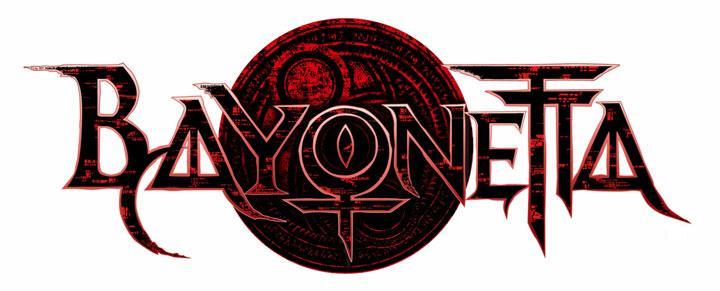Last updated on March 4, 2013
I’ve said this before for Devil May Cry, but this game is like a letter of challenge to players. I think, a game for hard-core players is now quite valuable. On this occassion, I would like you players to rise to this challenge. This is our letter of challenge to you, but when you receive it and hone your skills, our challenge-letter will change one day into a challenge for yourself. I want you to challenge your limits and master this game…We have packed this game with many elements. And there will be information which you won’t understand by looking on the internet…I want you to dive into this game a number of times. We hope you will love Bayonetta for many years to come.
-Hideki Kamiya, Directer of Bayonetta
Before discussing Bayonetta, it’s extremely important to examine its ancestral line and its predecessors. It’s a more revolutionary game than many have previously believed, and the comparisons to God of War or mindless “beat ’em ups” are downright tragic. In fact, Bayonetta equals a melding of the arcade and the home experience, brought to life with an exuberant and completely insane visual style, visceral combat, and complex mechanics that demand and reward mastery. Honestly, not many modern games really achieve that level of stupendous perfection, but Bayonetta, even with its relatively minor flaws, is definitely one of them, for this or any generation of video games.
Now, I could certainly pile on hyperbole after hyperbole, here, and not really reach any notable destination. What then, makes Bayonetta such an excellent game? Bayonetta might have the label of “PlatinumGames” on itself, but the product’s design only bows to the whims of one man: Hideki Kamiya. Kamiya is a product of his influences as much as anything else – rather, not influences, but games that he loves and holds dear. According to the Bayonetta Limited Edition Guide, he cites three game as his particular favorites: The Legend of Zelda: A Link to the Past, Gradius, and Space Harrier. All three, subtly produce their fruit within Bayonetta’s mechanics and style.
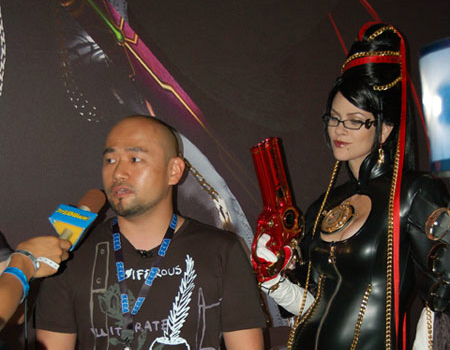
Firstly, A Link to the Past has been revered by the game community at large forever for its perfection of, at the very least, the two dimensional Zelda formula. We can imagine that this success derives from several elements – exploration, simple combat augmented with a variety of weapons and abilities, and the feeling of childhood wondering from the bright and colorful graphics. But, none of these elements would meld into a fully-formed masterpiece without good planning. For Zelda games, planning remains key to the experience. Unlike, say, a Metroid game, which almost dares the player to push the limits and play elements of the game out of their intended order for speed, the Zelda series takes a much more relaxed tone. It plays out in a completely linear fashion for the most part, especially in the dungeon sequences. Yet many say they love Zelda’s exploration, and love dungeons. What gives? Doesn’t this contradict the very essential elements of the Zelda formula?
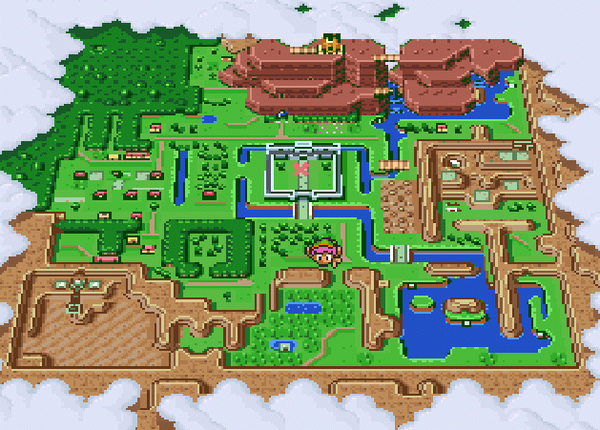
Where it succeeds, then, is deceiving the player into thinking he or she is exploring a vast world when, really, they are following the developer’s intended path. Zelda games always contain hidden paths and items, but not all of these are neccessary. Thus, for those who want to complete the game, as well as those who want to nudge and work their way around every nook and cranny to find how devious Nintendo’s developers can become when given such a world, both parties find equal satisfaction.
Kamiya, understanding this very element, has created a very linear game. However, he uses the perception of its linearity to its advantage. There are myriad hidden items – weapons, health power-ups, special challenges, you name it – hidden throughout the game. Some take advantage of the player’s diverted attention; others are hidden by the direction of the camera. Certainly, no one will deny that Bayonetta contains an entirely linear group of combat setpieces lined one against the other like dominoes, yet even these elements contain room for exploration! Honestly, this fact suprised me greatly after my first playthrough; I had only obtained a few of the weapons in the whole game, and to find nearly six or seven more (and I haven’t even gotten the rest yet) was almost unbelievable. It’s no wonder that Kamiya says of LttP that “This game should be displayed in museums, as one of humanity’s treasures. It’s planning is godlike.”
Furthermore, this extensive planning lends itself to these setpieces – like dominoes, each combat sequences or cutscene simply builds the tension of the action to an absolute breaking point, spread across nearly twenty hours of game. In fact, I’d say it gets crazier and crazier, and when you think it can’t get any more crazy…well, it does. Because this is Bayonetta, and this game is, literally, eight or nine years of Kamiya thinking about how he could improve the Devil May Cry experience.
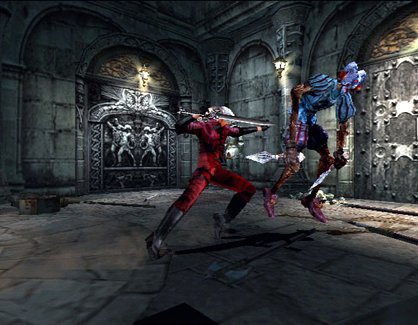
Granted, DMC1 was a fantastic game. Based originally on a build of the next Resident Evil game, the project transformed into what we now call a “stylish action game”, something new and probably impossible with the previous generation of hardware. It combined the 3D action game with a scoring system not unlike those of the arcade scene, where shmups and fighters still retain scoring systems (the latter, for reasons I still don’t comprehend). Still, this lent the game its own replayability, as well as presenting a number of difficulty levels that increasingly changed the way the game had to be played, especially with the time limits imposed on Dante Must Die! mode. Enemies don’t just remain the same on each subsequent level; they gain new attacks and new abilities. They come in different combination. Even bosses can switch their tactics.
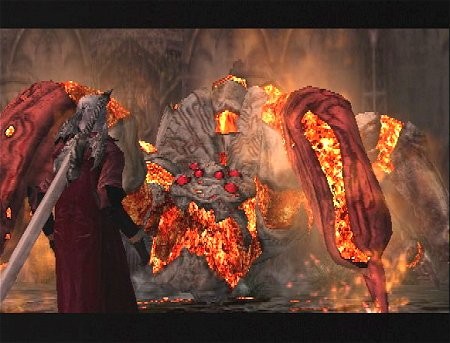
Although those aspects are not true of the arcade, they can be done on a home console – Bayonetta adopts these from the original Gradius. Kamiya reminisces about the first time he played Gradius, and saw the Option system. In Gradius, unlike other 2D shmups of the time, the player is allowed to change and edit his shot trajectory by picking up powerups. These appear when enemies die or explode, allowing the player to choose whether or not to take that particular powerup. Of course, what’s interesting with Gradius is the variety in choices – not only do you find these weapons, but you also gain Options – literally, a tiny spaceship that follows the main craft around. These tiny crafts usually emulate what the main ship has as its weapon, and can be arranged in a number of ways to create, for example, a wall of lasers or fire, or perhaps concentrated fire. Konami provides the players with seemingly limitless firepower that, to Kamiya, was amazing for its time; how could the game provide such unbelievably powerful weapons? Still, it works; the weapon choice and positioning functions at the same time as you’re trying to avoid enemies from every direction and planetary objects as well. And this is a game that takes the standard notions of one hit deaths quite seriously. In sum, Gradius presents the tools to the player, and it is up to them to use them correctly.
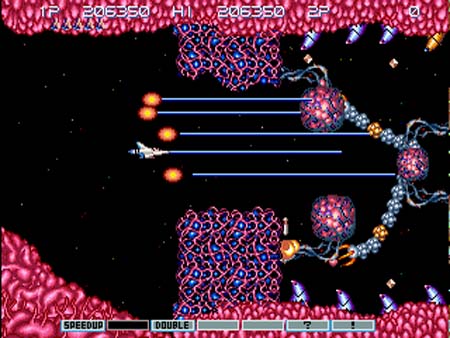
One can see this trend with Bayonetta as well. How many weapons are there in the game? At least 8 unique ones, followed by a few more powerful variations, and the fun item (Rodin; go play the game). Since Bayonetta uses both punches and kicks, many of these weapons equip on both hands or legs, changing movesets and doubling the amount of use (with the exception of swords and nunchaku) That’s not even to mention a variety of accessories that can shield damage, give you the ability to parry attacks with good timing, increase enemy strength (mostly done for score/combo ability), health regen, extra damage from minions, automatic dodge (with magic power gained from combat), double/triple attack buffs, automatic magic charge, and some other fun objects for those who’ve played the game before. That’s not to mention that Bayonetta herself has HUNDREDS of moves which either subtly change to reflect your current equipment or rework the move-sets entirely for a new experience. Honestly, it’s unbelievable that there’s this much work put in, but as Kamiya thinks, we give the player the tools, and they do what they want with them.
But Bayonetta also provides an arena to use those weapons. There is a triptych of goals within every Bayonetta situation: one, to defeat enemies, and two, to get the highest score possible by being the most stylish, and third, defeat all enemies quickly. Like Devil May Cry’s chapter division in various levels, Bayonetta’s combat sequences divide into verses where you are individually scored for performance. Can you ignore these entirely? Certainly; the same way you can play Easy Automatic mode, which basically plays the game for you with one button the whole way. But obviously, this is not how the game is designed. The developers intend for players to succeed by becoming better at the game. At first, your scores will, frankly, be absolutely horrific. There’s really no way to avoid this. Bayonetta throws lots of “impossible” situations at the player with alarming frequency.
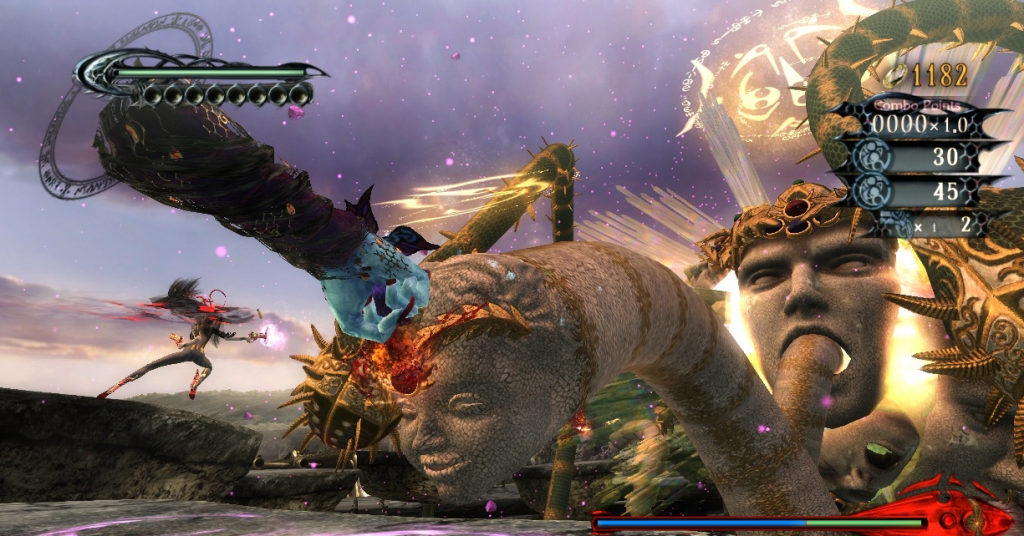
Well, impossible from the perspective of the observer. Kamiya’s other favorite game, Space Harrier, was a revolution in this sense. Not only did it fully utilize Sega’s current system hardware in full color (65335 different colors, for those curious), it also presented seemingly impossible situations to the player. Kamiya watched a player at the arcade blaze through what appeared to be the final stage with the greatest of ease, even though he could barely comprehend what was occuring on the screen. However, he realized that this beautiful, colorful, insane game was only on its SECOND level. It is in that sense that Kamiya says he puts all his respect for Space Harrier into Bayonetta, and it shows.
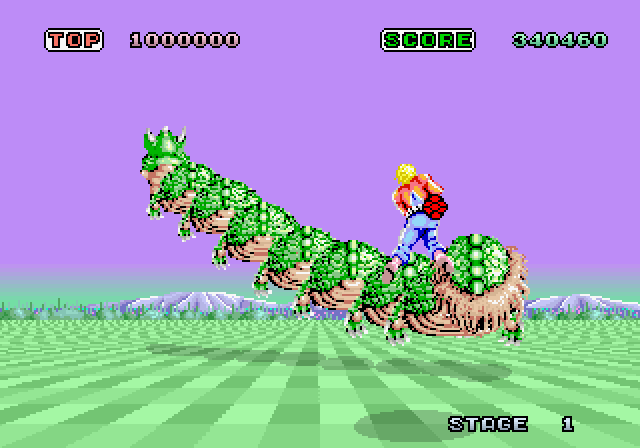
So here’s some footage, for anybody who’s never seen Space Harrier.
Does Bayonetta look crazy? Absolutely. Half the time, any new player will be completely swamped by Angels (the game’s main antagonists) who seek Bayonetta, a witch, and want her to die. The game throws you into the fray from its very first sequence, and you;ll get hit. Alot. But you’re allowed to make mistakes. Perhaps the biggest problem many gamers have with Bayonetta’s combat is its fluidity. Now, this might seem odd, but Bayonetta provides no block button whatsoever. There is no way to stand in place and simply “defend” against one’s enemies. Instead, Bayonetta only allows dodging, and dodging attacks at the last second activates Witch Time, a Bullet-Time like effect that allows you, the player, to attack the enemies, now in slow motion, at full speed. It also double the points you gain from successful attacks. So there’s a two fold objective: to kill enemies, and get points. Sounds like any arcade game in the world, right? There’s also a magic system, which stores points for flashy Torture Attacks, which looks exactly as they sound, but provide you with a breather. Why would you need that?
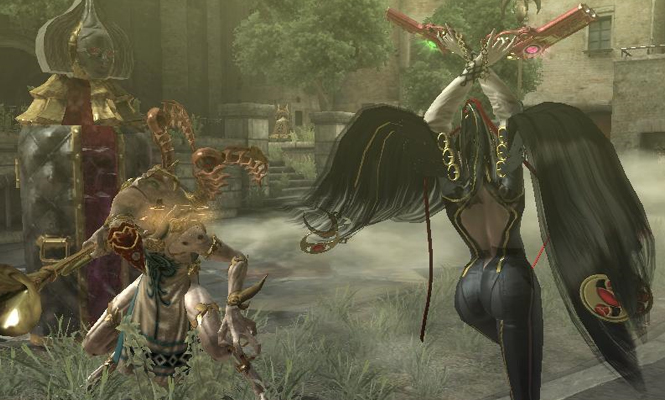
Stuff is happening; lights flash, enemies explode, yell at you (in a made-up language that is actually translatable, by the way), throw all sorts of projectiles and new enemies pop into the fray continually. And all this to the tune of “Fly Me to the Moon”? Describing it In two word, it’s total chaos. Being thrown into the deep end is, frankly, exciting. I like being treated like I am, at the very least, competent with a controller and the basic design of a video game. The game’s depth shows itself right away, and that’s fantastic. As Kamiya says, “From the very start, this game was developed for the ‘core’ gamers. Our aims and the player’s feeling about those aims have matched nicely.”
But the difficulty is never “unfair”; it is merely a process of learning, pattern recognition, and quick reflexes. Everything in the game has a predictor, whether it be a motion, a sound, or a quick flash. These might throw the player’s game off the first time, but the player is supposed to learn from that experience. Thus, the next time a simialr circumstance occurs, they can avoid it even when the enemy attacks from outside the player’s point of view, offscreen, or anywhere else.
It is, furthermore, unfair if the developers (Kamiya’s idea) give the player an unintuitive control scheme that makes it, literally, impossible for a player to win. Thus, the game needs to flow, play, and work for the player’s benefit. Because the game runs (on the Xbox 360 version, anyway – don’t bother with the PS3 unless you have to play it there) at 60 fps, fluidity remains a hallmark of Bayonetta’s combat. Everything works perfectly at the touch of the button. Over time, Bayonetta’s movements become a literal extension of your own will, and it is in this that Kamiya succeeded brilliantly. As well, this fluidity comes accross with evasion as the key tactic; one is never encouraged to stop moving in Bayonetta, and thus there’s a sort of rythmic quality that, over time, allows the player to succeed in ways they couldn’t have dreamed when they first started playing.
Of course, this isn’t “just like the arcade” at all; however, it is the arcade experience as translated to the console generation. There’s no one hit deaths here until you reach some of the extra content. And boy, do you get a lot of that! In fact, what’s interesting about the extra unlockable is that many of them make the game harder. Usually, such bonuses are a touch and go affair; you get God mode, become invincible, mow down enemies and become bored.
Kamiya is not a lazy director. Instead, we get multiple difficulty levels attached to the main game, each of which change the game slightly. They are balanced with the tools and powerups gained from Normal, so Hard mode (for example) slams the player with more enemies which do more damage. Furthermore, the score and time requirements for high rankings (which go from Stone at bottom, Bronze, Silver, Gold, Platinum, and Pure Platinum) become more stringent. Timing becomes much more important, but what else would a player want to do? They don’t want an easier game; that’s what happened when I became proficient with the game in my original playthrough. Rather, I want MORE challenge, something to really kick my butt and strive for me to learn the mechanics more and more thoroughly.
Infinite Climax mode provides even further difficulty. The enemies aren’t harder, but the game has been tuned because Witch Time has been removed in its entirety. This makes the game even faster and more intense, but the task is very much doable for anyone who wants to conquer and master. For those even more inclined to play again, two additional characters can be unlocked; they play like Bayonetta and have her arsenal, but their mechanics change slightly. Possible spoilers ahead, for anyone forewarned. Jeanne only activates the Witch Time mechanics at the very frame at which an enemy attack would land; this makes much of her playthrough like Infinite Climax. She also has an unlimited number of dodges; for those who don’t know, Bayonetta can only dodge 5 times in a row, which limits her mobility. Of course, Bayo activates Witch Time much easier, which means Jeanne actually needs that to compensate as she takes 50% more damage. Her scoring requirements also change drastically, as her Witch Time gives double points. Lastly, King of Little Devils Zero is a joke character, but for all the one-credit clear people out there, Zero provides that fun experience as he can only sustain two hits of damage total. He also gains magic at a much faster rate than the other two, obviously balanced by his lack of stamina.
These are little things, I know, but the game itself holds so much depth that these little changes add to a lot, and change your approach on even the simplest encounters. It’s almost like relearning the game. That’s even before I mention Angel Slayer mode, a gauntlet-style continuous encounter that throws waves of enemies, and bosses, at you continous with absolutely no health powerups, just you and your skill against the world. There’s the super super secret boss, as well, and even the game’s enemy designer couldn’t beat him (although many, not including myself, have since).
All in all, I haven’t even scratched the surface here, and it’s difficult to put this in words. However, these words will do: play this game! It’s a great game! Now it’s cheap, as well, so you have no excuse.
There’s a few things that have turned people off to the experience, however. First, the plot doesn’t make any sense. It’s literally a bunch of crazy hot nonsense. But I like nonsense. Kamiya, as he himself admits, has a boundless imagination that just thinks of the craziest stuff he can find and just runs with it. That’s what allows the grand finale to be hilarious and awesome at the same time. I hate spoiling it, but how many other games allow you to drive a motorcycle up a spacecraft for no apparently sane reason, or fight a giant god in space, and then steer him/her/it into the sun? It’s a game through and through; I get to do amazingly crazy things that all come from human imagintion and ingenuity.
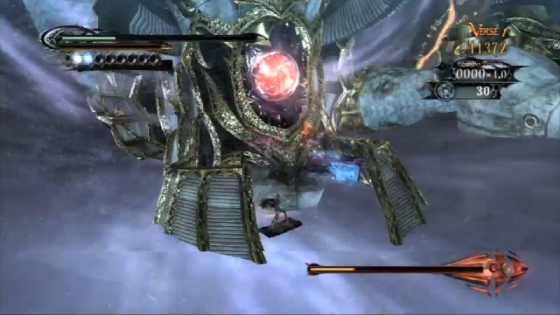
At times like this, I think of the divine breath within all of human creation; when God, in Genesis 2, does the following:
Then the Lord God formed man of dust from the ground, and breathed into his nostrils the breath of life; and man became a living being. 8 The Lord God planted a garden toward the east, in Eden; and there He placed the man whom He had formed.
God has imbued humanity with a divine breath, a divine spark (as it’s more commonly known) that allows us to have these crazy imaginations, and has led (for both good and bad) into the production and creation of vast civilizations, new technologies, and total dominion over the earth. And also, this game. I imagine this comparison seems insignificant, even slight. But there’s something to be said for the little pleasures in life like Bayonetta, just something so over the top and insane you can’t just help but crack a smile in glee. Honestly, I am surprised at how much I enjoyed it.
We might ask, furthermore, why shouldn’t we be allowed to challenge ourselves, even in an utterly useless (for the real world, anyway) enterprise? I’ve always wondered what Christianity has to do with our pursuits in entertainment and media, but I think the answer is simple: even playing a video game should reflect the kind of life a Christian lives. As Paul says in Colossians:
12 So, as those who have been chosen of God, holy and beloved, put on a heart of compassion, kindness, humility, gentleness and patience; bearing with one another, and forgiving each other, whoever has a complaint against anyone; just as the Lord forgave you, so also should you. 14 Beyond all these things put on love, which is the perfect bond of unity. 15 Let the peace of Christ rule in your hearts, to which indeed you were called in one body; and be thankful. 16 Let the word of Christ richly dwell within you, with all wisdom teaching and admonishing one anotherwith psalms and hymns and spiritual songs, singing with thankfulness in your hearts to God. 17 Whatever you do in word or deed, do all in the name of the Lord Jesus, giving thanks through Him to God the Father.
Not that the Apostle Paul would be talking about a woman who wears guns on her heels, but who knows. More conservative Christians, anyway, mostly aren’t enamored with it. In everything you do, one must do that as well in the name of Jesus Christ. Why shouldn’t this also extend to a challenging video game? That’s what I tend to do, anyway, not that playing a single-player 3D action game can, in any way, be construed as “service” or anything of that ilk. Our actions in every facet of life demand a response that is Christian, and that extends to moments of frustration and anger at games – because, seriously, who hasn’t gotten angry at a game to the point of throwing a controller on the ground or against a wall (maybe not a universal experience)? Even in that kind of situation, we must press on and continue. That’s as true in life as in video games. Perseverance and hard work give reward, even if that reward isn’t attached with tangible, physical benefits (just like Christianity, it would seem). The easy way to summarize this is with the easy verse from 1 Corinthians 10:31 – “Whether, then, you eat or drink or whatever you do, do all to the glory of God.”
There’s one other issue that has caused a great deal of tension about Bayonetta: feminism. It has, alternatively, been viewed as a paen to the wonders and joys of being a woman, or a disgusting sexist display of how men think women should be portrayed in video games. Most people would simply wave these criticisms away with a wave of the hand, but I suppose there’s some merit to that argument; after all, how many games have a woman who has clothing made of her own hair attack people with said hair, and inadvertently strip off her own clothing in the process? That’s not to mention, for example, that the lock-on targeting symbol is – get this, a pink lipstick kiss, and anytime Bayonetta takes damage, she turn the blood that would appear into roses. Double jumps make butterflies appear; I mean, seriously, it’s bizarre, and I can see what, for example, God of War makes more American men feel real hetero, rather than having to explain to their mom/girlfriend/wife why they’re playing the silly girl/sexual exploitation game. There’s even poledancing! Yeah, we’re really moving forward now, ladies!
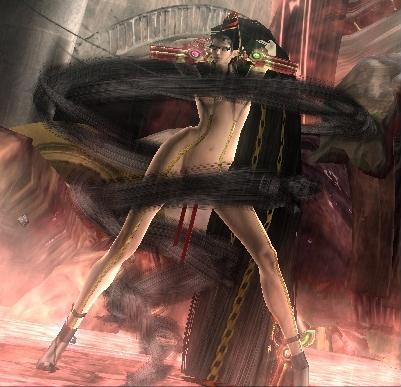
Of course, there’s quite a few facts that go against any accusations of sexism. Kamiya, quite literally, decided to switch the theme of his games – usually, they’re characterized as “male” games, but the theme for Bayonetta is “woman”. Kamiya presented his initial idea for Bayonetta (which was a pretty vague outline at the time) to his designer, Shimazaki, a woman herself. As he says,
I felt sure that she would be the only one who would be able to create Bayonetta’s character design. Of course, she can take a unique idea and create a design that works. Most of all, she is a designer who pays a great deal of attention to detail, particularly from the woman’s perspective. Something men don’t have. Sure, this is a 3D battle action game, but I didn’t want typical male imagery: a battle-capable woman in battle suit. Since we had a woman as our main character, I wanted to create a fashionable design. We needed a person who was interested in fashion in their private lives as well and who would be able to reflect this in the design. She was the only person who I thought could do this, and I wanted her to create the design at any cost.
And, to further drive the point home:
The typical female character has big boobs and shows her skin – a male image of women, designed to win men’s facor. This type of design happens all the time. Women’s beauty is not like that. This is what I always told her. And I think she got that. I said, please avoid any poor taste. Erotiscism is something that every man can imagine easily. I wanted to create a character who wouldn’t be offensive to women. Her back is quite bare. This was her idea. This method of showing skin has a woman’s touch. An open back is an elegant way to show skin like a dress…This type of presentation is very feminine. I guess these elements are key to successful design in Bayonetta.
Is Kamiya a sexist? We could go into this all day long and not come up with anything substantive. Let’s say, at the least, that he has a particular idea of women, and that’s what is in the game. Is it neccessarily horrible and exploitative? Not that I can say. Kamiya tends to “imagine” his character acting, working, and moving in particular ways. Bayonetta does the moves one way, while Jeanne does the other. Bayonetta dodges on the ground because, hey, her clothing is made of hair and can’t get dirty. Jeanne, on the other hand, does not roll EVER, because she bought her expensive clothing from the imagined fashion line D’arc. I suppose some of the extra costumes obvious appeal blatantly to some weird fetishes (schoolgirls and cheerleaders, anyone?) but I’m honestly not offended. I guess that’s because I’m male and have no free will, right?
And let’s go further and say: why take this game so seriously? It obviously isn’t trying to tell me a world changing message of any kind. It’s just a platform for fun. Not to derail this article, but feminism represents a return to the earliest human societies. The intent is separation, conflict, and winning the war against one’s enemies, in this case the ideological oppressors and under the guise of academic scholarship. The goal for these groups is conquest, victory, and regnancy for their particular interest group to which all others should bow, not an equal society. They believe in a cosmic narrative, of their own founding, which places them as the victims on the “right” side of history, and all who oppose them as the oppressors. Eventually, the tide of history will turn their way and the oppressor will be vanquished.
Robert C. Neville, professor of philosophical theology at Boston University, notes of feminism (and other “revolutionary” ideas) “…are themselves unrevolutionary modernist developments of European modern thought, the very thought against whose institutionalized culture the social revolutions are believed to have addressed.” In Neville’s thought, these \revolutionary” theologies rely on the Enlightenment idea of power and the idea of narrative. They rest under the same assumptions as the rest of society; for it to truly “represent” women, they need to remove the idea of gender altogether, really. But none are willing to take that step. Let’s say that Galatians 3:28 should be our high water mark; the rest of this attempt to place people in particular positions based on some arbitrary quality is diametrically opposed to any Christian perspective. We are beyond boundaries and the limitations in human communication, in that sense, and to re-establish them again, just to resettle the balance, still doesn’t remove the essential conflict of sin in the world. Why place a new class system on everyone? How far is this against the idea of Church?
I would, furthermore, add that the developers, in creating this world, have obviously thought long and hard about every aspect of the game, even the designs of the characters! Bayonetta wears glasses, for example, because she had a traumatic experience as a child and does this to mask her true face. Even the ribbon on Bayonetta’s head actually means something (it’s her name written repeatedly, but incorrectly because she didn’t learn it that well). Even if she represents herself in that fashion within the game, Kamiya imagines all his characters as having personalities, traits, and emotions as expressed through their style. It’s why Dante always looks cool and collected, or why Viewtiful Joe has the “special pose” and the tongue sticking out (he’s a movie nerd) – personality and style are one and the same when it comes to an aesthetic medium. And anyone’s who has played the game know that Bayonetta isn’t just a sexual object for men to ogle; she is a character and a person, in addition to being a supernatural angel slayer. She even has a love interest, who happens to be the weakest character in the entire game as presented by the story. Seriously, do these critics ever play these games?
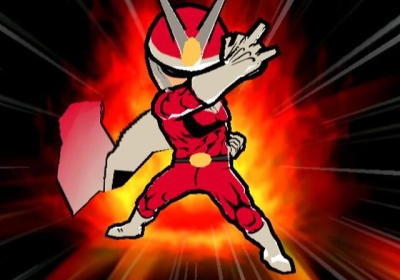
The designs reflect the care and dedication placed at every level of design. The myriad references to other games and pop culture (which I most certainly won’t spoil) also attest to how much care was placed in the whole experience for the player’s enjoyment and challenge. The music, as well, shows nice variety with its 5 CD soundtrack, moving from intense synthwork to smoky lounge jazz. I love the music because, as odd as it is, it fits the tone perfectly. The above picture of Viewtiful Joe even gets a mention, as well as Kamiya’s other games (the Okami reference should be so obvious that I’m not going to tell you).
It’s pretty telling, I think, but all of these elements combine into one magnificent game. The thought put into literally every aspect of the game shows true creativity and mechanical perfection. Unless you’re against the aesthetic because you have preconceived notions of what’s good and what’s bad, I can’t imagine anyone not thinking this game an inheritor of a vast array of influence, molded and refined to a single purpose. That’s why it’s on The List, after all. I’m just sad that I can’t include Kamiya’s other games! The guy has a way with games because he simply loves them and knows what makes a great one from a merely good one. This is a great game.

